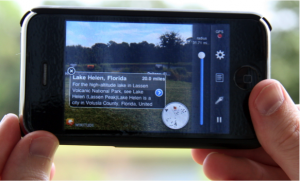The Puget Sound computer science capstone class is a relatively recent addition to Puget Sound’s curriculum. The capstone class involves completing a semester-long development or research project. I just finished taking the class, and my group released an app for iPhone and Android called, “Imbue,” available here:
Working on this project was hands down the best development experience I’ve had to date. I’ve developed my own software before and released a few apps, but working with this group was inspiring. It led to numerous new ideas, and working in a group made development extremely fast.
The basic premise of our app is that integrates Augmented Reality technology into existing mapping tools, like Google Maps and social media. Augmented reality basically involves augmenting one’s view of the world with additional data and information. It often takes the form of overlaying information on top of a camera’s view of the surroundings, like this:

We initially set out to design a similar app that would help facilitate campus tours for the University of Puget Sound. We provided these overlays for all the buildings, designed an interactive map to visualize campus, and also integrated the app with Facebook to find events happening on campus for visitors.
We realized a couple of months into the project that, in doing this, we had also built the framework for a much larger app. By simply adding data from points of interest databases and fine-tuning our Facebook integration, we were able to very quickly provide augmented reality views for any building or event in the world.
We also added features for identifying your current location on a map to Facebook friends. While testing the app, I was able to find out where a couple of my group members were working and go join them to work on the app.
Shortly after, a couple of our features got nabbed. Facebook rolled out the “nearby friends” feature, while Google released a similar interactive map view. But the core functionality – displaying augmented reality views of buildings and events anywhere in the world – remains unique to this app.
Plus, we designed our own lightweight augmented reality system in one semester that runs quickly and works anywhere. As far as I know, there are very few similar augmented reality systems available for smartphones.
So thank you to a great group – it was a pleasure to spend so many late nights working away in the computer lab. I was extremely lucky to work on a senior capstone project in my junior year. More than anything, this project’s rekindled my inspiration for development and software entrepreneurship.
So thanks, team Imbue!


